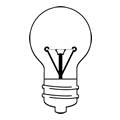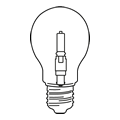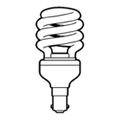05 Mar Are LEDs affecting your sleep or making you blind?
With energy efficiency a top priority these days, many of us are turning to the newer generation of LED lighting which is expected to account for 75% of all lighting by 2020 (Goldman Sachs International, 2016; WikiPedia, 2018). LEDs are present in our cell phones, home lighting, smart TVs, fridge lighting and digital devices. Many of us take for granted the artificial light we use in our daily lives, and are unaware that using a digital device in the evening is effectively telling your body that it’s midday, which suppresses melatonin (sleep hormone) and confuses your circadian rhythm. The net effect of this is reduced sleep quality, tiredness and a downstream cascading flow of negative biological outcomes. In contrast, the full spectrum lighting that occurs when watching the sunrise or sunset has a distinct red/orange tinge of colour, which regulates our circadian rhythm.
| Type of Light Bulb | Photo | Description |
| Incandescent lamps |  |
Next to sunlight, these lamps are the healthiest form of lighting that have been used for over 100 years. Unfortunately the Australian government has been phasing them out since 2009 (Energy Rating, 2018). |
| Halogen lamps |  |
Whilst these bulbs are more efficient at generating the same amount of light with less power used, they emit AC electric fields, AC magnetic fields and UV radiation. They are generally used for highlighting, rather than general purpose illumination. |
| CFL (compact fluorescent light) |  |
CFL bulbs are more energy efficient and produce less heat, however they are hazardous if broken, due to the mercury content of the bulb. They are the worst choice if you are electrically sensitive, because they emit high AC electric and magnetic fields, UV radiation and radiofrequencies. Give it a miss. |
| LED & Smart LED |  |
Cool white LEDs should be avoided. Warm option LEDs are best used for task lighting where the area lit is within 1 metre from the LED. |
The problem with cool white LED lighting (4000K) is the large amount of blue light emitted and very little red light as opposed to the warm colour range LEDs (3000K). The way energy efficiency is achieved in cool white LED lighting is in the way it strips out the heat (infrared). Blue light has various side effects from suppressing the sleep hormone (melatonin) which further prevents the onset of sleep and circadian rhythm, and it impacts the regeneration of cells in your eyes which may lead to age-related macular degeneration.

Graph: LED emits blue light as opposed to other forms of lighting (Tosini, Ferguson and Tsubota, 2016)
To take a precautionary approach to such blue light hazards, there are a number of actionable steps that can be taken to minimize any health impact.
- Expose yourself to sunlight during the day (especially the morning). Obviously avoid this when the UV index is high (check the Bureau of Meterology website HERE).
- Avoid using your smartphone, watching TV or using a digital device at least an hour or more before bed. Enjoy the sunrise instead.
- Replace your CFL and cool white LED lights with incandescent light such as the OLED battery operated candle light from IKEA.
- Use blue-light blocking glasses at night if you need to use a digital device. They are amber/orange spectacles that eliminate all blue colours in your vision.
- Ideally the home would contain a variable lighting system that takes into consideration the different times of the day.
* morning – 4000K* lunch – 5700 – 6000K* night – 2000-3000K* bedtime – 1000-2000K
Energy Rating (2018) Step 1: Choose which type of bulb | Energy Rating. Available at: http://www.energyrating.gov.au/lighting/types-of-light-bulbs (Accessed: 27 November 2018).
Goldman Sachs International (2016) Technology in the Driver’s Seat THE LOW CARBON ECONOMY EXCERPTED FROM THE ORIGINAL: See inside cover for details. Available at: www.gs.com/research/hedge.html. (Accessed: 19 October 2018).
Tosini, G., Ferguson, I. and Tsubota, K. (2016) ‘Effects of blue light on the circadian system and eye physiology.’, Molecular vision. Emory University, 22, pp. 61–72. Available at: http://www.ncbi.nlm.nih.gov/pubmed/26900325 (Accessed: 27 November 2018).
Wikimedia Commons (2014) File:Leds sodium spectrum fr.jpg. doi: 10.1890/14-0468.1.
WikiPedia (2018) Light-Emitting-Diode. Available at: https://en.wikipedia.org/wiki/Light-emitting_diode (Accessed: 27 November 2018).NOTE: All graphical images are licensed under the Creative Commons 3.0 Licence.
